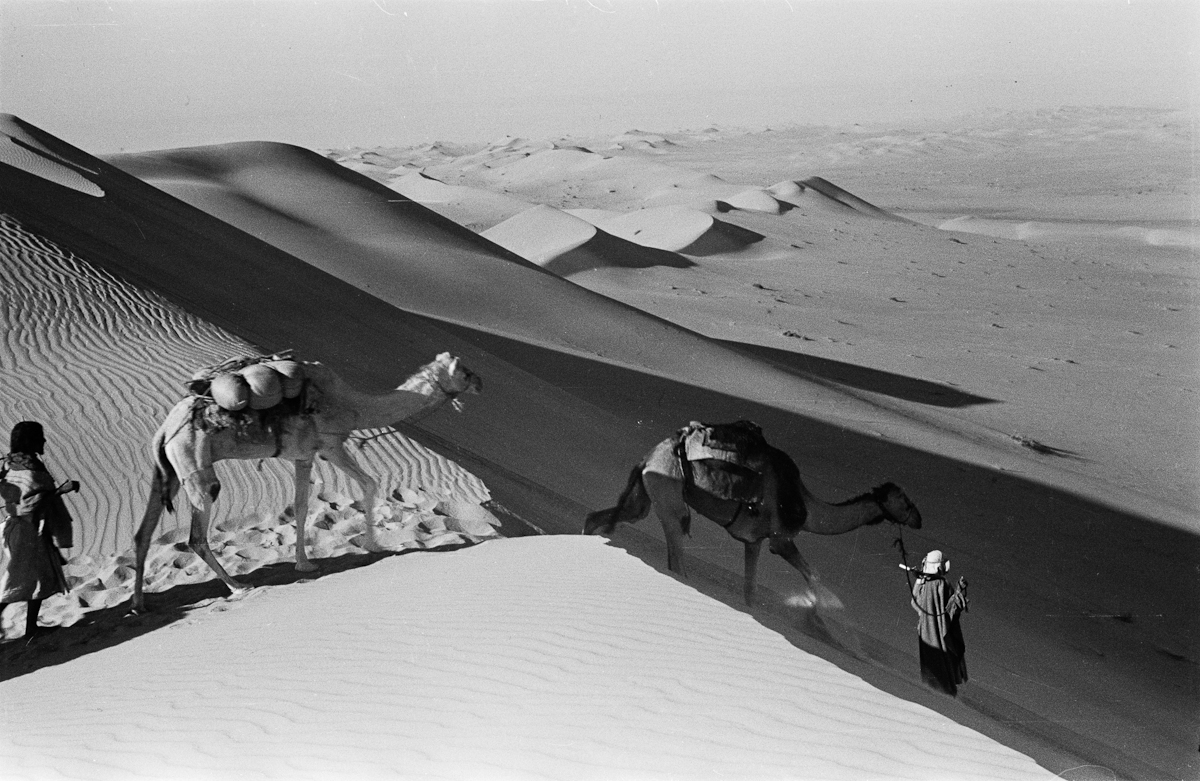Thesiger's Journeys in Arabia - Second Empty Quarter Crossing 1947-8
 2004_130_12990_1-OJourney dates: December 17, 1947 – March 14, 1948
2004_130_12990_1-OJourney dates: December 17, 1947 – March 14, 1948
In December 1947, Wilfred Thesiger returned to Yemen to embark on a second crossing of the Empty Quarter (Rub' al Khali). During his previous journey, Thesiger had completed a difficult traverse through the desert's eastern sands, starting at Mughshin Oasis in the southeast and crossing over the 'Uruq ash Shaybah to Liwa Oasis. For his second expedition, Thesiger planned a route through the western sands starting at Manwakh well in Yemen and heading northwest into Saudi Arabia.
Although less technically demanding than his previous journey, this route was substantially more dangerous. King Abdul Aziz Al Saud (Ibn Saud) had refused Thesiger's request for permission to enter Saudi Arabia, and so Thesiger would have to leave Manwakh without causing suspicion of their real destination. On January 5, 1947, Thesiger and his small party of trusted Rashid Bedouin companions filled up their water skins at Manwakh well and headed out across the 'Uruq az Zayza. With Thesiger were his companions from the Bayt Imani lineage of Rashid Bedouin – Salim bin Kabina, Kabina's brother Muhammad bin Kalut, Salim bin Ghabaisha and 'Amair bin 'Omar – and two Sa'ar Bedouin guides, Salih and Sadr.
Continuing northwest across the 'Uruq al Awarik and Al Jaladah Plain, the party turned northeast at Jabal al Jilat to reach 'Ayn al Hasy well, a Saudi government post, in mid January. Arriving in nearby As Sulayyil, the party was detained by the Wali of Sulayyil, with Thesiger's Rashid companions shackled and jailed. Although Thesiger had known that King Ibn Saud would be displeased, he hadn't realized how severe the consequences could be for his companions and was deeply distressed. However, with the help of St. John Philby, then an advisor to King Ibn Saud, Thesiger and his companions were later freed to continue their journey.
After travelling north to Layla, the party turned east and crossed the Jawb al Badu to Jabrin Oasis. After a stressful, cold and hungry journey to Ad Dibin well, the party crossed the Sabkhat Mutti and Al Dhafra to arrive in the Al Batin sands at the beginning of March. From Liwa the party turned north, crossing the As Saruq and Baynunah sands on their journey to the coastal city of Abu Dhabi, which they reached on March 14, 1947.
For Thesiger, this journey was an achievement, not only of physical endurance and fortitude, but one of friendship and camaraderie:
'we had lived under considerable strain and nearly always had been short of food and water. I had been drawn along a road of my own choosing by the lure of the unknown and had been rewarded by our achievements. My companions, by nature realists, might well have hung back at Manwakh or hesitated to continue without a guide from Laila. Had they refused, no other Badu would have accompanied me in their stead. I owed everything to their light-hearted gallantry, their constancy and endurance.' (Thesiger 1949: 43)
Named Individuals: Abdullah bin Maiqal [Abdullah bin Nura], 'Amair bin 'Omar, Muhammad bin Kalut, Sadr, Salim bin Ghabaisha, Salim bin Kabina, Wilfred Patrick Thesiger
Represented Cultural Groups: Bani Yas, Rashid Bedouin, Karab Bedouin, Sa'ar Bedouin
Locations: Raydat as Say'ar , Manwakh, 'Uruq az Zayza, Al Jaladah, Bani Ma'arid, 'Uruq al Awarik, Al 'Aradh, 'Ayn al Hasy, Layla, Jabrin, Jawb al Budu, Dhibi, Al Dhafra, Al Batin, Liwa Oasis, Dhafir, Jayf, Al Qafa', As Saruq, Al Maqta, Abu Dhabi City.
References:
Wilfred Thesiger, 1949. 'A Further Journey across the Empty Quarter', The Geographical Journal, Vol. 113, (Jan. - Jun.).
Wilfred Thesiger, 1960. Arabian Sands, Longmans, Green and Co Ltd: London.
Images:





































































































































































































































































































































































































































































































